Controversial Utthita Trikonasana: is it necessary to lengthen both sides of the torso?
22As yoga teachers we know that the way we move in and out of the pose is just as important as what we do while holding the pose. It couldn’t be more true for Utthita Trikonasana. The way you move into the pose will determine which parts of the body get engaged, which parts get stressed and what your entire experience in the pose will be.
The most common way of moving into Utthita Trikonasana is by hinging at the front hip. In fact, this is so widespread that oftentimes the teachers don’t even question whether or not it is the best idea. Is it?
Let’s analyze the following instructions from the Yoga Journal website and try to understand the reasoning behind them:
“Exhale and extend your torso to the right directly over the plane of the right leg, bending from the hip joint, not the waist… Rotate the torso to the left, keeping the two sides equally long. Let the left hip come slightly forward and lengthen the tailbone toward the back heel.”
1. Why should be bend from the hip joint and not the waist? What is wrong with flexing the spine? Here we are not talking about rounding the spine forward, but flexing it laterally, which is a legitimate movement of the spine. Your thoracic spine can bend sideways about 20 degrees and your lumbar spine can bend sideways about 20 degrees as well (on average). As we discussed in an earlier post, lateral bending is useful for the spine. We don’t do much of it in the daily life, and yoga practice is an excellent place to work with it, so why would we want to avoid it at all costs here? If you decide to “hinge from the hip”, you will be resting the weight of the entire upper body over your right hip and pulling very strongly on the hamstrings and inner thigh muscles. This also increases the risk of collapsing into the hip joint. If you flex your spine laterally, the weight of the body will be distributed more evenly between the spine, the hip and the front leg.
2. Why should we keep both sides equally long? I am not advocating collapsing on the bottom side, we would still want to lengthen the spine. But having the bottom side shorter then the top side is perfectly normal and simply means that the muscles on the top side of the torso (obliques, quadratus lumborum (QL), illiacus, tensor fasciae latae (TFL) and iliotibial band (IT band) are stretching, while the same muscles on the bottom side are contracting. By “keeping both sides equally long” you will shift the emphasis to the hips mostly and forgo all the benefits for the lateral structures of the torso.
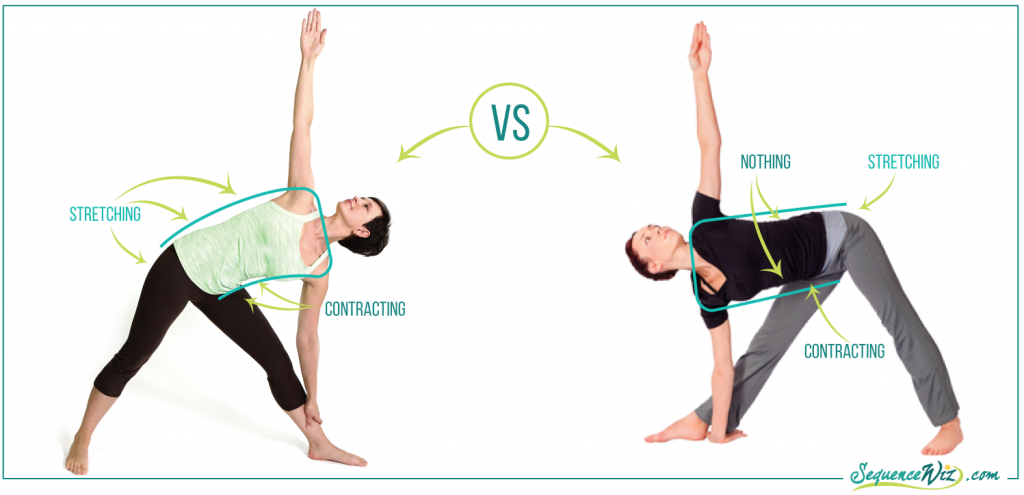 In addition, in your effort to lengthen the bottom side of the torso and lengthen the tailbone toward the back heel you are likely to push the bottom hip deep into the socket which will encourage your pelvis to tip forward (rotating to the right). At the same time you are rotating your torso to the left (including your spine and sacrum) which is the opposite direction. This creates a pull on your sacroiliac joints. It wouldn’t be so bad if you weren’t bearing weight in this position, but you are, in fact you are bearing most of your upper body weight on that right hip, which means that your right SI joint is loaded while you are tugging on it by encouraging the pelvis to go one way and the spine to go the other way. Do it enough times and you will destabilize the joint.
In addition, in your effort to lengthen the bottom side of the torso and lengthen the tailbone toward the back heel you are likely to push the bottom hip deep into the socket which will encourage your pelvis to tip forward (rotating to the right). At the same time you are rotating your torso to the left (including your spine and sacrum) which is the opposite direction. This creates a pull on your sacroiliac joints. It wouldn’t be so bad if you weren’t bearing weight in this position, but you are, in fact you are bearing most of your upper body weight on that right hip, which means that your right SI joint is loaded while you are tugging on it by encouraging the pelvis to go one way and the spine to go the other way. Do it enough times and you will destabilize the joint.
On the other hand, if you focus on lengthening the spine without pulling your bottom hip in and move only as far down as your body is willing to go, you will be placing much less stress on the SI joint. Even then, if somebody has acute SI joint issues, we usually recommend that you keep the feet parallel when bending sideways to take the external rotation of the hip out of the equation completely. The range of motion will be more limited, but your sacrum will be more stable.
So the viniyoga instructions for Utthita Trikonasana will look like this:
Keeping the shoulders in the same plane as the hips, bend sideways to your left and place your left hand on your left leg. On the inhalation lengthen the spine and lift the chest away from the navel, with the exhalation contract the abdomen creating stability. Continue to breathe like that.
I believe that this kind of description is much more user-friendly and involves much less subtle body manipulations that are not necessarily useful for most practitioners.
How do you teach Utthita Trikonasana and why?

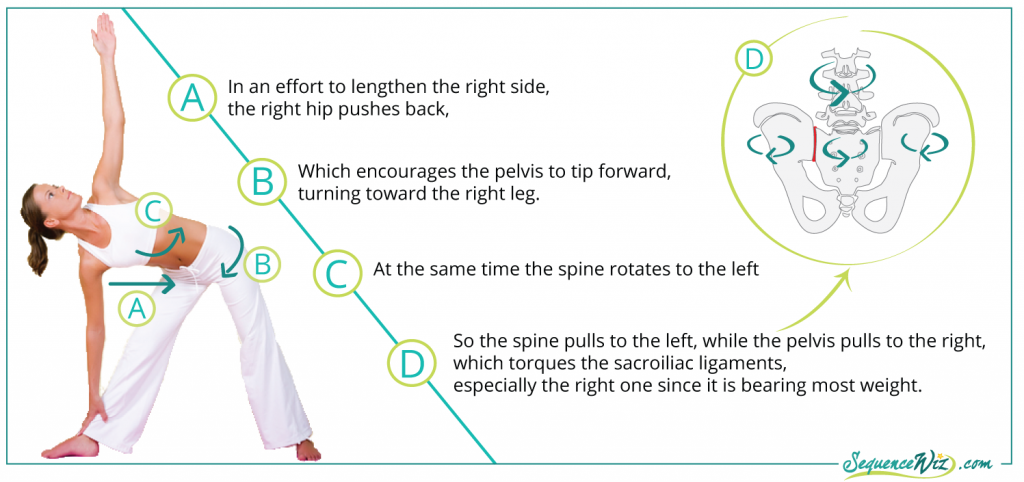
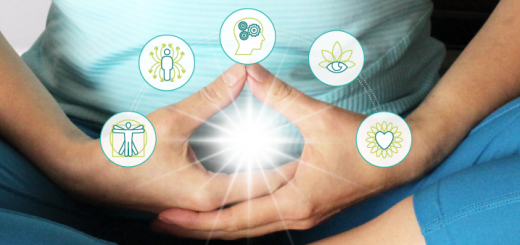
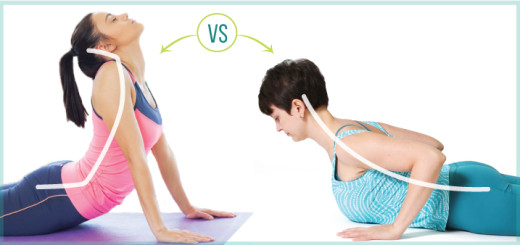
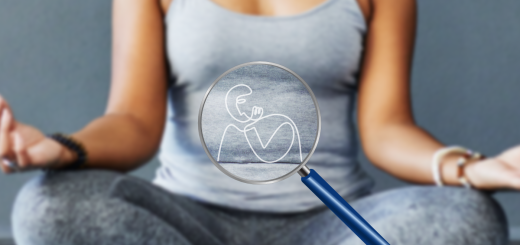
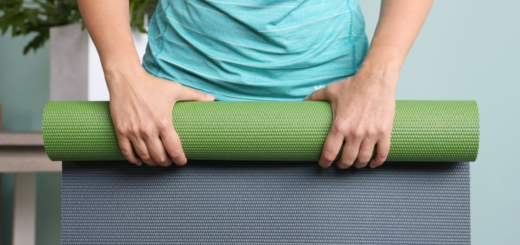















I very much agree with this however, I am also an advocate of coming into this pose from the ground up by bending the knee first and then straightening and lengthening. If I teach it from the standing position I instruct to just take the lateral movement of the spine without any reach.
Thank you for your addition Ann! Do you mean coming into Utthita Trikonasana from the Side Angle? I can see the benefit of that!
i disagree with your point #2. The QL and obliques of the top side are working to prevent the spine from collapsing laterally toward the floor, especially if the hand on the leg is not bearing much weight. If you keep both sides equally long, the top side muscles will be working on a neutral length. If you let them stretch, they will be working on a long length. Both are possibly advantageous depending on the desired outcome. The muscles on the bottom side are not doing very much work at all either way. Just because a muscle is shorter doesn’t mean it’s contracting. Just think of chatturanga: the biceps get shorter as the elbow bends but they do not work to achieve the action. If one thinks of poses in terms of the work performed against gravity at different muscle lengths, then trikonasana will work the top side muscles on a neutral length and the extended hamstrings on a long length.
Hi Jason! I can see your point. In my tradition we usually move in and out of the pose several times before holding it, and every time you move into Utthita Trikonasana you definitely contract the bottom side of the torso. When you hold the pose it certainly depends on what you do while you are there. For example, check out this quick video of how one can emphasize the lateral engagement of the torso:https://instagram.com/p/6lNX-UlN4N/?taken-by=ok.yoga And then you can emphasize the stretching of the top side with something like this: https://instagram.com/p/63C-WmlNzS/?taken-by=ok.yoga And I completely agree with you – it is all about the desired outcome!
All well and good, but don’t we move SIJ and spine in opposite directions in every twist? Not to go with this too far, and no injuries or instabilities will ensue. As to putting all the weight onto a hip joint – yes, it pulls strongly on hamstrings and ligaments: the nearest example is upavistha konasana. Again and yet again, not to go too far and no to do too much – is it not the main point of the metier?
Hi Alexander – absolutely! I wrote a bit about it here: http://sequencewiz.org/2015/06/24/how-to-protect-your-sacrum-during-twisting/ Here is an interesting thing about Utthita Trikonasana – you have to be quite flexible/loose in the hips to be able to do this pose with both sides equally long; at the same time it is the same population (very flexible folks) who have the most trouble with sacrum instability. I just wish I heard fewer people say” I hurt myself doing Triangle” 🙁
Which still means that classic way trikonasana is NOT to be seen as more dangerous than any other asana. Neither one of them is often met in a routine life, each one demands doubled-tripled-quadrupled caution. On the other hand, the classic performance – if nothing else – brings with it something, say, exotic. Paradoxically, this facilitates more attentive, more prudent approach from student.
Hi Alexander! That’s the tricky thing – this is not the classic way to do Utthita Trikonasana. This way was taught by BKS Iyengar and came to be viewed as some sort of “golden standard”. According to my teacher Gary Kraftsow who also studied with Sri Krishnamacharya (BKS Iyengar’s teacher), this is not now Triangle was taught. This is my point – we need to be able to question any form of the pose and figure out whether or not it is appropriate for what we have going on in the body.
That’s really great, that’s why I love your posts – always to ask! The answer shall be sought by every one as specific adaptations tuned to specific demands. Please don’t stop to invest into investigations!
The practice of spirals, or balancing the nutation/counternutation action of the pelvis in twists has changed my practice, the way I teach, and relieved my sacroiliac issues. I use this also in my yoga therapy sessions correcting pelvic imbalances with great results. Sometimes it resticts the impressive intensity of the twist (no longer does one look like the cover of a yoga magazine) but it prevents and treats injury. Thanks Olga.
Thank you Tracy! That’s right – who ultimately cares about picture-perfect twists if it means living in pain?
I’m curious what you think of the instruction in the link here. A student of Judith Lasater’s demonstrates Ms Lasater’s reconsidered approach, which moves the pelvis/sacrum as one by deeply tucking that bottom hip back into the socket. I’m really having a hard time figuring out this pose w/o tweaking my SI (or something else) and this particular set-up had helped. But it seems very different from your approach here.
https://yogainternational.com/article/view/keep-the-sacrum-and-lower-back-safe-in-trikonasana-triangle-pose
Hi Andrea,
This is how I do it, begin in Triangle Prep aligning the feet, pivot the torso toward the front leg, hinge as if doing a forward fold over the front thigh, use blocks for each hand so you don’t lower and round the spine, the hips are even (sort of like Parsvotanasana) Place the outside hand on a block, place the inside hand on the top hip, (don’t turn the torso yet, your flat back, extended over the front leg still. Then rotate the hip of the front leg, -( think as if your about to take Crescent moon on the front hip) roll the hip like you would turn the wheel of the car, this turns the pelvis as a unit and is actually too me much more stable. Then extend the top arm in your traditional way, I come out of it the traditional way, .. It is difficult to get this without visuals.
Hi Andrea – I will check this out!
Andrea: Thank you for the link to Tanya Boigenzahn’s video. The video is exceptional at demonstrating the modifications to the triangle asana. I started studying Anatomy and Kinesiology with ASFYT and is it changing how I practice, and as a teacher-in-training, it has changed how I teach and cue Triangle pose. Judith Lasater has become an important touch stone for my yoga practice.
Hi There,
I think the approach is variable. I like to not get stuck in any one way, the more variation we explore the more tissues are nourished. I think one key to move slowly, mindfully and with an inquisitive attitude. Sometimes I use Triangle as a hip extension (I use Judith Hanson Lasaters approach) which you can find in her book 20 essential poses (and she is a physical therapist) plus I love the way it feels getting into the pose.. and I also explore some ideas presented by Jules Mitchell – bio mechanical educator/yoga teacher.. I think it is all relative to the goal.. Do you want to nourish lateral flexion? You need to side bend.. Do you want to focus on hips laterally opening, then do that.. The may thing is to move with integrity, slowly and with control. When movements are fast and furious as in a rigorous flow, I notice students control of muscle is not there, they get sloppy.. I use a lot of analogies to weight lifting, the weight in case of yoga is of course the body… If you want to move quickly, go for a hike, jog, swim, bike, dance, etc..
Hi Olga, thanks for, yet another, insightful and well explained article. I have a question on the foot placement. From the video it appears as though your right foot is placed quite close to the long side ‘front’ of the mat while the left foot is placed closer to the long side ‘back’ of the mat. I would interpret this as standing on railway tracks as opposed to a tightrope. It appears that, if you were to draw a straight line from your left heel it would meet your right heel, would that be correct? Is this to ensure there is not too much pull on the right SI joint? Or perhaps your feet are actually lined up with the left heel intersecting the right arch and it just looks different due to the camera angle?
Hi Jessica! Yes, this is correct – I usually keep the heels aligned rather then aligning the heel to the arch. Technically it is not that much of a difference, but I do it because I believe that it supports the back hip in moving slightly forward when you bend sideways. We don’t want to tip the hip forward too much, but we also do not want to keep yanking it back in the effort to the keep the entire pelvis in one plane – this is where it becomes problematic for the SI joint of the front leg. So it is always a juggling act 🙂 So I think of the foot position as more accommodating for a wider range of students. 🙂
Hi Olga, I would just like to say how much I enjoy your website. I spend hours reading your posts! Please write a book so everything is in one place!!!
Thank you Zoe! Yep, the book is in the works, I just need to get organized 🙂
With the right foot/leg forward, does the top hip (left) internal rotate as the left rib cage externally rotate upwards? I’m yearling yoga teacher and have been the practice for 15 years… I have been taught nothing about the activity in the left side pelvis and hip other than allowing it to do whatever out of the fundemental for itself. Please clarify. I recently attended a Judith Lasater workshop and she made a gentle suggestion of engaging this area in the way for this pose. Help. I want to instruct this key posture correctly with or without this subtle cue. Thank you.
Isn’t it best to practice trikonasana with legs parallel as it can still cause loosening the SI joint region resulting in acute and later chronic pain if practised regularly. “Mostly any position that exerts an asymmetric force on the halves of the pelvis can potentially create strain on the soft tissues stabilising the sacral region” (Ganesh Mohan). Also the strain on the knee.